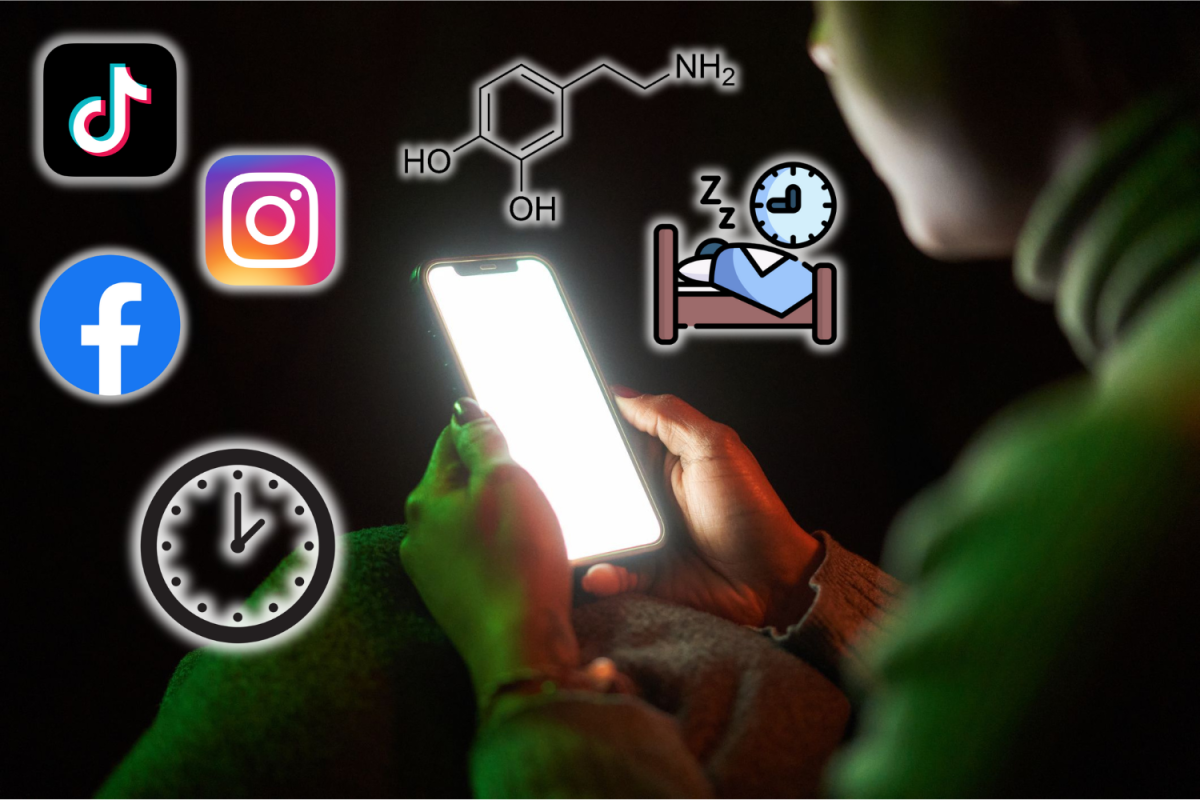In a digital age of online connection, entertainment, and occupation, it can be difficult to unplug from cell phones. Most do not bat an eye at the routine use of these gadgets. However, they can quickly become addictive if usage becomes excessive, according to thenewstribune.com. Experts carefully craft phones to be as addictive as possible, offering instant distraction, stimulation, and happiness, which, if users overindulge in, can lead to behaviors similar to substance addictions. In fact, researchers observe that the detrimental effects that unrestrained screen time has on the brain are comparable to those of substance addictions, according to theguardian.com.
Americans’ phone usage has steadily increased over the past year. In 2025, Americans spend an average of five hours and 16 minutes per day on their cell phones, which is a 14 percent increase from 2024, according to harmonyhit.com. Members of Generation Z (Gen Z) spend the most time on their devices daily and are most dependent on their devices with 69 percent admitting to phone addiction. Americans also say that social media apps, such as TikTok, YouTube, and Facebook, are the most addictive, according to addictionhelp.com. Companies design most mobile apps to elicit addictive behavior by providing an instant dopamine rush, according to campusmentalhealth.ca.

“Doomscrolling” is a term used to describe the act of mindlessly scrolling through social media posts or news stories, seemingly without the ability to stop. Members of Gen Z are particularly likely to fall into this unhealthy habit due to the higher amounts of time spent on screens and the underdevelopment of their brains. Dr. Courtney Batt, adolescent medicine expert at University Hospitals, explained how the immediate gratification provided by doomscrolling can lead to unhealthy practices, according to uhhospitals.org.
“As with many other addictive behaviors, doomscrolling activates the release of dopamine in the brain,” Dr. Batt said, according to uhhospitals.org. “So even though it often leads to negative feelings such as depression and anxiety, endlessly scrolling also offers the positive feelings associated with dopamine. The more you scroll, the more dopamine is released to reinforce and reward the behavior.”
This dopamine rush is not the only thing keeping users’ eyes glued to the screen. From online shopping to online dating, the effects of having entertainment and responsibilities at their fingertips can quickly become unhealthy. Senior Amy Walsh, Co-Head of the Sacred Heart Greenwich Student Digital Wellness Task Force, shared how brands design phones to lure in users.
“The causes of phone addiction in our digital age are deeply woven into how we’ve structured modern life,” Amy said. “Speaking from observation, I’d say a major cause is how we’ve made phones essential for literally everything from paying bills to maintaining friendships. Social media companies have perfected the art of keeping us hooked through endless scrolling and personalized content. There’s also this constant fear of missing out that many of us feel. People get anxious when they’re disconnected even for a short time. [COVID-19] really accelerated this by making phones our primary window to the world. Plus, many workplaces now expect 24/7 availability through phones, creating this cycle where we can never truly disconnect.”
The growing reliance on cell phones and excessive use of them affects the brain and behavior in ways similar to substance abuse, according to theguardian.com. Overuse of social media can yield the same behavior in impairing decision-making that drug addictions do. These behaviors also lead to similar symptoms of greater mental illness and social isolation. Researchers have additionally linked phone overuse to neurotransmitter dysfunction in the brain and a loss of grey matter, which they observe in substance use disorders as well, according to addictioncenter.com. However, unlike these addictions, researchers do not yet understand the long-term effects and potential harms of excessive phone usage, particularly social media usage. Amy commented on how society can often downplay phone addiction as merely a sign of modern life.

“Phone addiction is definitely taken less seriously than other addictions because it is so normalized,” Amy said. “People have their phones out at dinners, doctors’ offices, in classes, and pretty much everywhere else. Phones are fully integrated into our culture, more so than other addictions because phones are more accessible to all ages.”
As phone use becomes chronic, the impact it has on the individual worsens, similar to the effects of a gambling addiction, according to addictioncenter.com. This can lead to increased stress, loneliness, insecurity, reduced cognition, lower concentration, and sleep deficit. In fact, 60 percent of Americans say they go to sleep with their phones and 89 percent say they check their phones within the first ten minutes of waking up, according to cbsnews.com. At night, in addition to the blue light emitted by screens delaying or disrupting sleep, the content of digital media can evoke feelings of fear, anxiety, or excitement, keeping individuals alert and interfering with sleep, according to sciencedirect.com.
Too much screen time can negatively affect young children and babies particularly, according to unicef.org. While parents often use phones to entertain or distract, screens can hinder crucial developmental processes, such as learning social skills or the ability to concentrate and focus. Long-term effects of screen addiction in children include impairments in cognition, problem-solving, creative thinking, and mental health, according to premierhealth.com.

Like other addictions, phone dependency requires a conscious effort to break the habit. Companies have created mobile apps, such as BePresent, to help users curb their addiction, according to bepresentapp.com. BePresent specifically uses the same psychological techniques that social media companies use to keep users addicted, but enforces a healthy relationship with screens. Amy expressed the essential concerns that society needs to address in order to combat these addictive behaviors.
“These under-the-radar addictions happen because not many understand what we’re really dealing with – it’s not just about willpower,” Amy said. “We could start by making digital wellness a standard part of education […]. We should normalize phone-free spaces and activities […] and [c]ompanies could be incentivized to design less addictive apps and features. But most importantly, we need to address why people are turning to phones so much – often it’s loneliness, anxiety, or boredom. Creating more meaningful in-person connections and community spaces might help reduce our collective need to constantly check our phones.”
Featured Image by Caroline Gammon ’26




